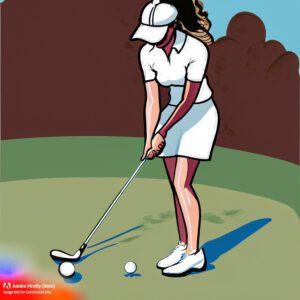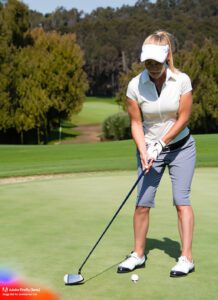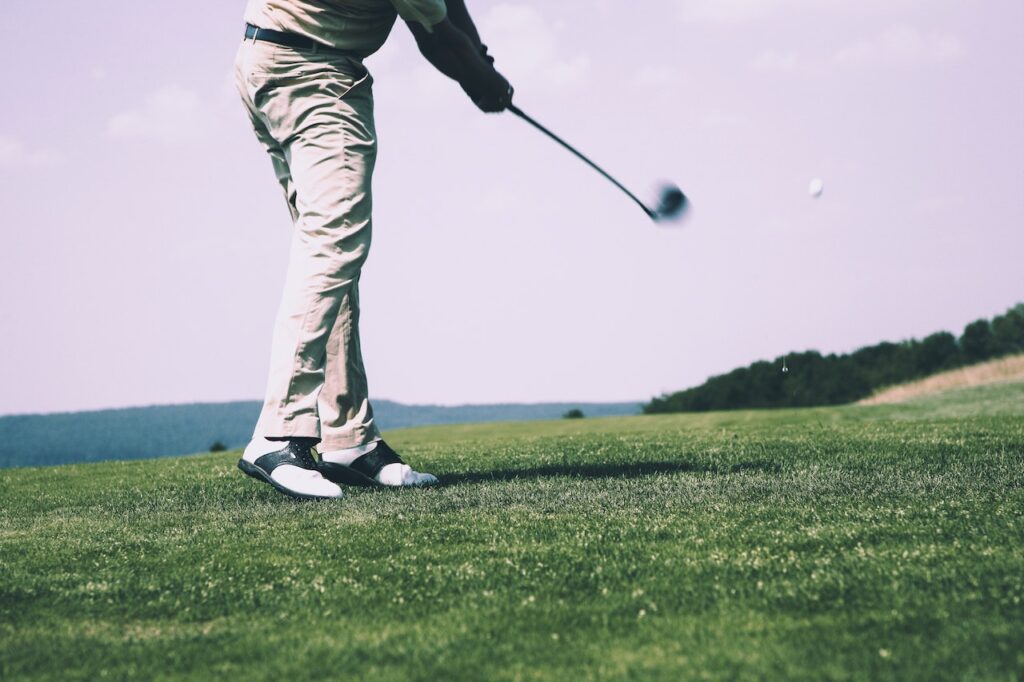Hey guys I am Donna Weiss and welcome to my blog. This article breaks down the keys to backspin – from proper strike angle, to spin-creating grooves and ideal ball compression.
Backspin is an incredibly useful golf skill for controlling shot height, and distance and getting your ball to stop quickly on the green. With some practice, you can master this technique that makes the ball spin backward after impact.
You’ll learn common mistakes to avoid and get troubleshoot for gear and conditions. Plus, handy drills so you can practice dialing in this ball-floating, green-stopping magic!
With these tips, you’ll be impressing your golf buddies by spinning majestic arcing shots that land softly near the pin.
Let’s get started with the basics of creating backspin!
Key takeaway:
- Backspin enhances control: Putting backspin on a golf ball allows for greater control over its trajectory and stopping power. This can be particularly useful in situations where precise distance and stopping accuracy are required.
- Factors influencing backspin: Understanding the concept of backspin and how it is affected by factors such as club selection, ball selection, and swing technique is crucial for creating effective backspin on a golf ball.
- Practice makes perfect: Incorporating specific drills and dedicated practice sessions into your training routine can help improve your ability to put backspin on a golf ball. Consistent practice and refinement of technique are key to mastering the art of backspin.
Understanding Backspin: What Is Backspin?
A golf ball with backspin spins backward after being struck. Golfers use this expertise to regulate ball trajectory, distance, and landing. The ball spins when struck with a downward stroke and closed clubface. Friction from the ball compressing against the clubface creates backspin.
Golfers must understand backspin to increase shot accuracy and game performance. Golfers must strike the ball with a descending blow and a closed clubface to achieve backspin. Put backspin on a golf ball requires skill and practice, but it can improve shot control.
Backspin also depends on angle of attack and dynamic loft. A steeper angle of attack causes the club to descend more, increasing backspin. Spin is also affected by dynamic loft, or effective loft at impact. Lower dynamic lofts reduce ball sliding up the clubface, increasing backspin.
A few pro tips can boost backspin. Golfers can practise striking with a somewhat open clubface and the leading edge. This technique boosts backspin by increasing ball-clubface friction. Backspin requires clubhead speed and control, which are achieved by keeping a constant swing pace and rhythm.
Golfers of all abilities must understand backspin mechanics. Golfers can improve their shot-making and performance by mastering this technique.
RELATED: How Long Do Trojan Golf Cart Batteries Last?
Why Do You Need Backspin?

Backspin in golf is needed for several important reasons:
- Control: Backspin allows golfers to have more control over where their ball lands and how it behaves once it hits the ground.
- Distance: Backspin can also increase the distance a ball travels. The spin lifts the ball into the air and keeps it there for longer, thus increasing its flight.
- Stopping Power: When hitting the green, the backspin helps the ball to stop quickly, minimizing the roll. This is crucial when trying to get the ball close to the pin.
- Wind Resistance: The backspin can help to stabilize the ball in flight and make it less susceptible to being blown off course by the wind.
- Loft: Backspin allows a golf ball to climb higher into the air. This is especially useful when golfers need to get over obstacles like trees or hills.
So, understanding and mastering backspin is an essential part of improving your golf game.
Three Considerations for Creating Backspin on a Golf Ball
Three Key Factors to Generate Backspin on a Golf Ball
To effectively produce backspin on a golf ball, there are three essential factors to consider:
- Club Selection – Choose a club with a higher loft angle to create more backspin. This allows the golf ball to stay in contact with the clubface for a longer duration, increasing the spin generated upon impact.
- Ball Positioning – Proper placement of the golf ball in relation to your stance is crucial. Position the ball slightly forward in your stance to strike it with a descending blow, compressing it against the ground and creating spin.
- Swing Technique – Employing a steep swing and steep angle of attack will enhance the backspin. By having a more vertical swing approach, the clubhead will strike the ball downward, imparting extra spin.
These three considerations, club selection, ball positioning, and swing technique, are vital for achieving optimum backspin on a golf ball. By leveraging these factors in your game, you can successfully execute shots that exhibit impressive backspin.
Furthermore, as you apply these principles, you will notice improved control over the ball’s trajectory, making it easier to stop it quickly on the green.
A Real-Life Success Story
One avid golfer, after analyzing his swing technique and making adjustments to his club selection and ball positioning, succeeded in generating substantial backspin on his shots. As a result, he consistently landed the ball closer to the pin, drastically improving his scoring average. With dedication and practice, his game transformed, inspiring others to apply these fundamental considerations for achieving impressive backspin on their golf balls.
How To Put Backspin on a Golf Ball
Let’s talk about how to make the golf ball spin backwards. Six main things have an effect on backspin.
1. How We Attack
2. Grinds
3. Angle of Club Face
4. Loft
5. Lawn
6. Speed of the swing
It might look like a lot, but I’m sure you can handle it all.
1. How We Attack
The angle of attack comes first. It is the line that your club head takes in order to make contact with the golf ball that is referred to as the angle of attack. When you have a more vertical angle of attack, it is simpler to get more spin on the golf ball. This is because your angle of attack is steeper.

2.Grinds
The following component is grooves. The grooves on the face of golf clubs are something that you have probably already seen. The reason why these are so significant is that they provide a place for foreign items, like as grass, water, and dirt, to go. This allows the ball to make contact with the greatest possible surface area of the club face.
To get the most spin out of your golf ball, you need to make sure that your grooves are clean (here are some golf towels that can be useful) and crisp. At least once every couple of years, you should switch out your wedges in order to ensure that you have grooves that are still in good condition. To add insult to injury, there is a widely held belief that rust imparts spin to wedges. Be sure to read our article in order to determine whether or not that is accurate.
3. Angle of Club Face
Lastly, there is the club face angle. At the moment that your club face makes contact with the golf ball, it is pointing in this particular direction. Whether the face of your club is open or closed, the golf ball will go in a sideways direction when you hit it.
However, in order to generate backspin, you need to have a square face at the point of impact. This is because a ball that is spinning horizontally cannot spin backward.
4. Loft
A club loft constitutes the fourth component. What you see here is the angle that exists between the face of your club and the centre of your shaft. The loft of a 9-iron, for instance, is more than that of a 4-iron.
The addition of loft will not only make it simpler to strike the club, but it will also result in the golf ball having a greater amount of spin. Consequently, if you want more spin, you should go with a club that has the highest possible loft.
5. Lawn
There is then a cut of grass. When we talk about the cut of the grass, we are referring to the length of the grass that is surrounding your ball. It is important to avoid having anything come in between the face of your club and the golf ball, as was mentioned in the paragraph that was just above the “groove” section.
If you play on grass that is shorter, such as the faimay, you will be able to make more solid contact with the ball and spin it more. Trying to spin the ball will be quite challenging due to the rough surface.
6. Speed of the swing
In result, the pace at which you swing has an impact on the backspin. The more quickly you swing, the more spin the ball will have when it exits the face of the player.
This does not mean that you should aim to swing as hard as you possibly can, but rather, in a manner that is analogous to the paragraph that was just mentioned about loft, you should be aware that if you select a club that requires you to swing it one hundred percent, it has the potential to generate more spin.
Avoid Mistakes while learning

- Do Not Rush: One of the biggest mistakes you can make is trying to rush the process. Learning how to hit the backspin in golf takes time and practice.
- Don’t Neglect Your Grip: Some golfers try to manipulate their grip to create a backspin, but this often leads to inconsistent shots. Stick with a neutral grip and focus on your swing mechanics instead.
- Avoid Over-Hitting: Trying to hit the ball too hard can result in a loss of control and won’t necessarily produce more backspin. Focus on a smooth swing where your club head smoothly contacts the ball.
- Not Considering the Lie: While it’s possible to hit a backspin from any lie, it’s much easier when the ball is sitting up on short grass. Don’t expect to create backspin when the ball is sitting down in the rough.
- Not Using the Right Club: The loft of the club plays a significant role in creating a backspin. If you’re using a club with too little loft, you’ll struggle to create a backspin.
- Don’t Neglect Your Stance: A proper stance is essential for any golf shot, including those where you’re trying to create a backspin. Make sure you’re in a balanced, athletic position before you start your swing.
- Avoiding Practice: Backspin is a skill that requires practice to master. Don’t expect to instantly get it right after a few attempts. Keep practicing and stay patient.
- Ignoring Ball and Club Conditions: If the ball or clubface is dirty or wet, it can affect the spin of the ball. Always ensure both your club and the ball are in the best possible condition before attempting a backspin shot.
- Not Asking for Help: If you’re having trouble with backspin, don’t hesitate to ask for help. A golf instructor or experienced player can provide valuable guidance and corrections to your form and technique.
- Do Not Forget to Follow Through: A complete follow-through is crucial for generating backspin. Make sure you’re not stopping your swing prematurely.
Other Considerations When Putting Backspin on a Golf Ball
Backspin plays a crucial role in golf shots, enhancing control and precision. To optimize backspin on a golf ball, it is important to take into account various factors. These considerations include:
- Club selection: The choice of club determines the backspin potential. Different clubs have different lofts and designs that affect the spin rate.
- Ball selection: The type of golf ball can significantly impact backspin. Balls with urethane covers are known to produce higher spin rates.
- Swing speed: A higher swing speed can lead to increased backspin. Controlled acceleration throughout the swing helps generate more spin on impact.
- Divot position: Placing the divot after the ball strike promotes optimal backspin. A divot before impact may decrease the spin potential.
- Angle of attack: A slightly steeper angle of attack can aid in maximizing backspin. This allows the ball to interact with the club face more effectively.
- Green conditions: The characteristics of the green, such as firmness and moisture level, can affect the backspin. Adjusting technique according to these conditions is important.
Covering all these aspects is crucial for achieving the desired backspin on a golf ball. However, other unique details, beyond what has been mentioned, must also be considered.
Maintaining a consistent grip pressure is essential for generating optimal backspin. Gripping too tightly can inhibit the necessary wrist motion, resulting in reduced spin. On the other hand, a loose grip may lead to a lack of control over the club. Finding the right balance is key.
Pro Tip: Experimenting with different combinations of club face angle, hand position, and swing speed can help uncover the perfect formula for generating maximum backspin. Practice and adaptability are vital for mastering this skill on the golf course.
Pros and Cons of Backspin in Golf?
| PROS | CONS |
|---|---|
| Control | Wind Sensitivity |
| Approach Shots | Difficulty Controlling Distance |
| Stopping Power | Limited Rollout |
| Shot Variety | Playing Conditions |
How to Put Backspin on a Golf Ball?
In Final Words of Mastering the Art of Backspin on a Golf Ball
Pro Tip: To further enhance the backspin on a golf ball, try using a specialized wedge with high grooves designed specifically for generating maximum spin. Practice hitting shots with this club to develop a feel for the increased backspin it produces.
Five Facts About How To Put Backspin on a Golf Ball:
- ✅ Backspin refers to when a golf ball spins backward in the air after being struck. (Source: Team Research)
- ✅ Generating backspin on a golf ball helps it hold the green and stop faster. (Source: Team Research)
- ✅ Speed plays a crucial role in creating backspin on a golf ball. (Source: Team Research)
- ✅ Hitting down on the ball and taking a divot helps create the necessary spin loft. (Source: Team Research)
- ✅ Good friction is essential for generating backspin, requiring clean, dry clubfaces and softer, premium golf balls. (Source: Team Research)
FAQs about How To Put Backspin On A Golf Ball
How can I create backspin on a golf ball when playing from a bunker?
To create backspin from a bunker, it’s important to consider the spin loft. Align your clubface to strike the sand just before making contact with the ball. By hitting down on the ball with the appropriate speed, you can compress it against the sand, generating the desired backspin effect.
What role does the front foot play in putting backspin on a golf ball?
The majority of your weight should be on the front foot when trying to put backspin on a golf ball. This forward weight distribution helps to create a downward strike on the ball, increasing the compression and allowing for better control of the spin.
How does the compression rating of a golf ball affect backspin?
The compression rating of a golf ball plays a role in backspin. Golf balls with a compression rating of around 90 are ideal for achieving backspin. Lower compression allows for better gripping on the clubface grooves, resulting in more pronounced spin on the ball.
What is the recommended club choice for generating backspin on a golf ball?
To generate backspin, it’s important to choose the right club. Ideally, you would use a club with a higher loft, such as a 7 iron or wedge. These clubs provide the necessary spin loft to better compress the ball and create the desired backspin effect.
Does the grass condition affect the ability to put backspin on a golf ball?
Yes, the condition of the grass can affect your ability to put backspin on a golf ball. Backspin is more easily achieved on closely mown surfaces, such as fairways or well-maintained greens. Rough or wet conditions can reduce the friction between the ball and the clubface, making it more difficult to generate backspin.
What role does the backswing play in putting backspin on a golf ball?
The backswing is an important factor in generating backspin. By bringing the club back in an upright position, you increase the angle of attack as the club head meets the ball. This helps to increase the compression on the ball, allowing for better control of the backspin.

I’m Donna Weiss, and I am the proud writer behind the captivating content you’ll find on golfneedy.com. As an avid golfer and passionate writer, I have combined my two greatest passions to bring you an incredible golfing experience. Through my articles, I aim to provide you with valuable insights, equipment reviews, and updates on the latest tournaments. Whether you’re a seasoned golfer or just starting out on this exciting journey, I am here to guide you and share my expertise. Together, let’s explore the fascinating world of golf, uncovering new techniques, and enhancing our skills. Join me on this thrilling adventure as we elevate our game and embark on an exciting golfing journey. Read More



